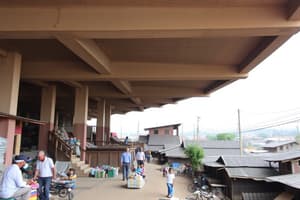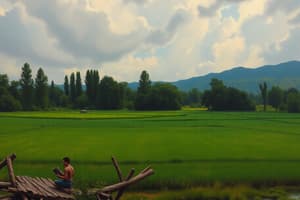Podcast
Questions and Answers
What is a consequence of horizontal inequality in a country?
What is a consequence of horizontal inequality in a country?
- Increased economic growth
- Decreased competition in markets
- Enhanced governance
- Major cause of conflict (correct)
What does the poverty-weighted growth rate aim to measure?
What does the poverty-weighted growth rate aim to measure?
- The benefits of growth for the wealthiest individuals
- Total national income regardless of distribution
- The average income growth across all social classes
- The welfare impact of growth on the poor more heavily (correct)
Which of the following stages of development is characterized by the transition to manufacturing?
Which of the following stages of development is characterized by the transition to manufacturing?
- Transitional stage (correct)
- Traditional stage
- Maturity stage
- High mass-consumption stage
According to the Fisher-Clark thesis, what happens as countries develop?
According to the Fisher-Clark thesis, what happens as countries develop?
What is commonly associated with high inequality in a country?
What is commonly associated with high inequality in a country?
What is a major reason entrepreneurs might refrain from investing in a country?
What is a major reason entrepreneurs might refrain from investing in a country?
What effect can weak institutions and poor governance have on a nation?
What effect can weak institutions and poor governance have on a nation?
What factor significantly contributes to unemployment in urban areas of developing countries?
What factor significantly contributes to unemployment in urban areas of developing countries?
What does the Gini ratio measure?
What does the Gini ratio measure?
Which type of inequality increases initially with development before decreasing, according to the Kuznets curve?
Which type of inequality increases initially with development before decreasing, according to the Kuznets curve?
What is disguised unemployment primarily associated with in rural areas?
What is disguised unemployment primarily associated with in rural areas?
What commonly characterizes horizontal inequality?
What commonly characterizes horizontal inequality?
What is a significant challenge for developing countries regarding their labor force?
What is a significant challenge for developing countries regarding their labor force?
What must the growth rate exceed for per capita income (PCY) to rise?
What must the growth rate exceed for per capita income (PCY) to rise?
What is the primary characteristic of employment in developing countries?
What is the primary characteristic of employment in developing countries?
What is the general savings-investment ratio in most poor countries?
What is the general savings-investment ratio in most poor countries?
What effect does Engel's Law have on agricultural goods demand?
What effect does Engel's Law have on agricultural goods demand?
Which of the following is a problem associated with rapid population growth in poor countries?
Which of the following is a problem associated with rapid population growth in poor countries?
Why do countries dependent on primary products tend to grow slower?
Why do countries dependent on primary products tend to grow slower?
Which region has the highest percentage of employment in agriculture among low-income countries?
Which region has the highest percentage of employment in agriculture among low-income countries?
What impact does over-reliance on primary commodities have on a country's exchange rate?
What impact does over-reliance on primary commodities have on a country's exchange rate?
What is a significant barrier to capital accumulation in developing economies?
What is a significant barrier to capital accumulation in developing economies?
What is the required savings-investment ratio for sustained growth in per capita income according to Rostow's theory?
What is the required savings-investment ratio for sustained growth in per capita income according to Rostow's theory?
Which factor is identified as a fundamental cause of underdevelopment?
Which factor is identified as a fundamental cause of underdevelopment?
What is a consequence of high population growth on government resources?
What is a consequence of high population growth on government resources?
What phenomenon is described as 'disguised unemployment' in agricultural sectors?
What phenomenon is described as 'disguised unemployment' in agricultural sectors?
Which of the following characterizes industries compared to agriculture in developing economies?
Which of the following characterizes industries compared to agriculture in developing economies?
What is the relationship between income elasticity of demand for primary commodities and manufactured imports?
What is the relationship between income elasticity of demand for primary commodities and manufactured imports?
Which of the following is NOT a factor contributing to underdevelopment?
Which of the following is NOT a factor contributing to underdevelopment?
In Kaldor’s growth laws, which aspect is emphasized as crucial for economic development?
In Kaldor’s growth laws, which aspect is emphasized as crucial for economic development?
What is the effect of rapid population growth on developing economies?
What is the effect of rapid population growth on developing economies?
What is Kaldor’s first law regarding manufacturing output and GDP growth?
What is Kaldor’s first law regarding manufacturing output and GDP growth?
What does Kaldor’s second law indicate about productivity in manufacturing?
What does Kaldor’s second law indicate about productivity in manufacturing?
What are some common characteristics shared by poor countries?
What are some common characteristics shared by poor countries?
Which hypothesis proposes that resources shifting from agriculture to industry raise productivity in agriculture?
Which hypothesis proposes that resources shifting from agriculture to industry raise productivity in agriculture?
What role does the manufacturing sector play in economic development according to the principles outlined?
What role does the manufacturing sector play in economic development according to the principles outlined?
What is a significant effect of industrialization on non-manufacturing productivity?
What is a significant effect of industrialization on non-manufacturing productivity?
What policy issue arises in relation to the resource shift into the manufacturing industry?
What policy issue arises in relation to the resource shift into the manufacturing industry?
Which of the following statements about income distribution in poor societies is correct?
Which of the following statements about income distribution in poor societies is correct?
How does the concept of vertical inequality differ from horizontal inequality?
How does the concept of vertical inequality differ from horizontal inequality?
What is the role of weak institutional structures in poor countries?
What is the role of weak institutional structures in poor countries?
Flashcards are hidden until you start studying
Study Notes
Characteristics of Underdevelopment
- Dominance of agriculture and petty services with over half of the population in rural sectors engaged as subsistence farmers, tenant farmers, or laborers.
- Low capital accumulation limits economic growth; per capita income growth requires a savings-investment ratio exceeding 10%.
- Rapid population growth in developing countries (>2% p.a.) leads to increased poverty and strains resources, despite a recent decline in birth rates.
Agricultural Sector Challenges
- Labour productivity in agriculture is low, averaging less than $500 per year or $1.90 a day.
- Diminishing returns result in disguised unemployment, particularly in rural areas.
- Demand for agricultural goods is income inelastic, while industrial products offer better growth prospects.
Export and Natural Resource Issues
- Economies dependent on primary commodities face long-term trade deterioration and balance of payment problems due to volatile prices and low income elasticity of demand.
- "Curse of natural resources" leads to slower growth, overvalued exchange rates, and corruption linked to resource extraction.
Institutional Weakness
- Weak institutional frameworks hinder economic development by diminishing investment incentives due to lack of property rights and governance.
- Historical factors, such as colonial extraction practices, have contributed to today's weak institutions, potentially leading to instability and civil conflict.
Employment and Inequality
- High unemployment and underemployment characterize poor countries, with significant hidden unemployment in both rural and urban areas.
- Income distribution is highly unequal, with both vertical (income inequality measured by Gini ratio) and horizontal (inequality based on demographics) disparities damaging development efforts.
Growth Dynamics and Distribution
- Inequality negatively impacts growth due to restricted opportunities and poor governance; welfare can be better measured through poverty-weighted growth metrics.
- Most countries undergo developmental stages outlined by Rostow, transitioning from agriculture to manufacturing, and eventually to service sectors.
Industrialisation and Economic Growth
- Strong relation found between manufacturing growth and GDP growth; this is supported by Kaldor's growth laws, indicating that manufacturing acts as a critical engine of growth.
- The shift of resources from low-productivity sectors (like agriculture) to higher productivity manufacturing raises overall productivity across the economy.
Kaldor’s Growth Laws Overview
- 1st Law: Positive correlation between growth in manufacturing output and GDP growth.
- 2nd Law: Manufacturing growth correlates positively with productivity growth in both manufacturing and non-manufacturing sectors.
- 3rd Law: Productivity in agriculture improves as resources shift to industry.
Overall Summary
- Common characteristics of poor countries include reliance on low productivity agriculture, low capital accumulation, and rapid population growth.
- Economic trajectories involve significant structural changes, moving through defined stages of development, emphasizing the importance of manufacturing as a growth driver.
- Institutional quality and equitable resource distribution are vital for sustainable development in less developed nations.
Studying That Suits You
Use AI to generate personalized quizzes and flashcards to suit your learning preferences.




